
The optimal decarboxylation of THC and CBD due by heating
By Dr. Med. Franjo Grotenhermen
THC and CBD should be heated before use in order for the pharmacological effects to be fully implemented. For the optimal way of taking cannabis it is essential to take care about the ideal heating.
Cannabinoids exist in the cannabis plant mostly under the form of the so called carboxylic acids. Heating converts the two THC acids (THCA) into phenolic THC, and the CBD-carboxylic acid (CBDA) into phenolic CBD. This process, whereby a carbon dioxide molecule is cleaved from the acid is called decarboxylation. Yet, only the phenolic THC causes psychological effects and most, although not all, therapeutic effects. A few seconds at high temperatures are sufficient for this process to occur, however, at lower temperatures, the heating time required increases to minutes or hours.
Nonetheless, if THC is heated for too long, it will be further oxidised into cannabinol (CBN), which exerts only low pharmacological effects.
What are the ideal conditions for the decarboxylation of cannabinoids?
Dr. Rudolf Brenneisen, a professor at the university of Bern (Switzerland), had already stated in the 1980s that a complete decarboxylation takes place when THC is heated for 5 minutes at 190°C without any relevant amounts of CBN emerging. In 2013, Dr Brenneisen presented a study concerning the decarboxylation of THC and CBD by using vaporizers. At a temperature of 210°C, four different vaporizers were tested, resulting in the almost complete decarboxylation of both THCA as well as CBDA. Both substances had been decarboxylated by more than 98 percent within few seconds.
Further information concerning optimal conditions for decarboxylation can be found in patents of the British company GW Pharmaceuticals. These refer to lower temperatures and a longer heating time. With these proposed methods, 95 percent of the carboxylic acid cannabinoids are converted into their phenolic form, while the degradation of THC into CBN is limited to 10 percent. The decarboxylation should preferably be performed in 2 steps: in the first step, the plant material is heated to a certain temperature for a relatively short period of time in order to evaporate residual water and to allow uniform heating of the plant material. In the second step, the plant material is heated for a longer period of time.
Preferably, the first step of converting THCA into THC is to be performed over a period of 10-20 minutes at a temperature in the range of 100-110°C. In the second step, the plant material is to be heated for around 60 – 120 minutes at 100°C – 110°C. At these temperatures, many terpenes (compounds responsible for the smell and taste) and several pharmacological effects of cannabis are preserved. In case that CBDA should be converted into the neutral CBD, 120°C for 60 minutes are indicated for the second step. The heated plant material can be further processed.
What preparation and consumption forms are optimal?
It is not necessary to meet the optimum conditions in terms of temperature and time of the heating; however, there are more suitable as well as less suitable preparations. A heating of 5 to 10 minutes at 100°C, as it occurs in the preparation of cannabis tea, causes an incomplete decarboxylation of the cannabinoids and leads therefore to low yield, according to Leiden University.
At 100°C the plant material should be heated for a time period of 60 – 120 minutes. This is, for instance, the method used in the production of cannabis extract olive oil. Here, a few grams of cannabis flowers can be added to olive oil or any other kind of oil, which is then be heated in a bain-marie for one or two hours. The cannabinoids and terpenes find their way into the oil while being simultaneously decarboxylated.
Cannabis flowers and leaves can equally be decarboxylated with some grease, in an oven or pan. However, one should be careful not to reach temperatures of more than 150°C because THC vaporizes at around 155°C.
In the production of hashish oil, a concentrated cannabis extract, with for example ethanol, only low temperatures are achieved since ethanol evaporates at 80°C. However, it is possible that an incomplete decarboxylation will be achieved. In this case, it might be better to perform a decarboxylation beforehand, e.g. in the oven, prior to extraction. Yet, there is no scientific data backing this methodology.
In the production of pastries with hashish or crumbled plant material, ordinary recipes can be used. The necessary temperatures of 150 – 160°C as well as the required backing time are close to optimum.
In extreme temperatures of 500°C to 900°C, as commonly occurring when smoking a cannabis cigarette, or when vaporizing cannabinoids at 210°C, a few seconds are enough in order to convert THCA in THC or, in other words, to ‘activate’ it.




